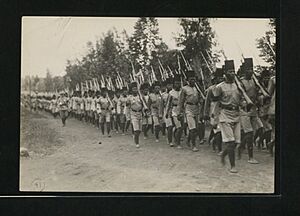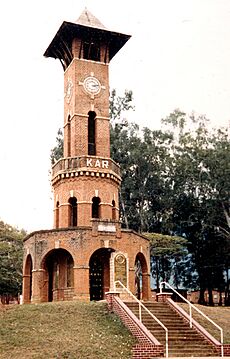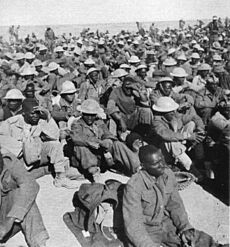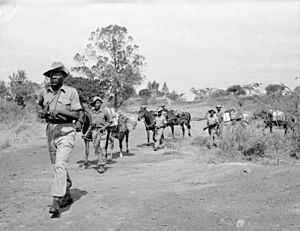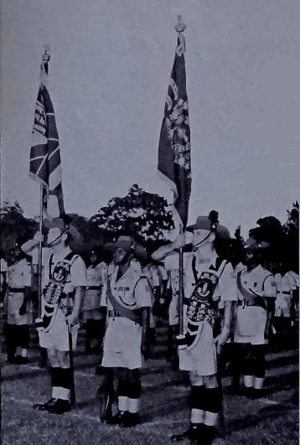King's African Rifles facts for kids
Quick facts for kids King's African Rifles |
|
|---|---|
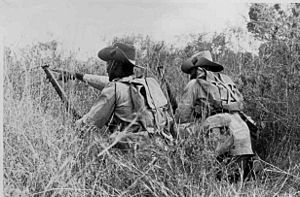
KAR troops training in Kenya, c. 1944
|
|
| Active | 1902–1960s |
| Country | |
| Allegiance | |
| Branch | British Colonial Auxiliary Forces |
| Role | Internal security |
| Size | 30,000 |
| Engagements | |
The King's African Rifles (KAR) was a special army unit formed in 1902. It was created by the British Empire in its East African colonies. This group mostly helped keep peace and order inside these colonies. They also fought in the two world wars and other conflicts. These included the Malayan Emergency and the Mau Mau uprising.
The soldiers in the KAR were African people. Most of their officers came from the British Army. In the 1960s, as African countries became independent, more African officers joined the KAR. The regiment was then slowly closed down. KAR battalions became the main part of new armies in East Africa.
Contents
What Did KAR Soldiers Wear?

Until these countries became independent, KAR soldiers wore special uniforms for parades. These uniforms were made of khaki fabric. They also wore tall fezzes (a type of hat) and cummerbunds (a wide sash). These sashes were usually red. Some battalions, like those from Nyasaland, wore black fezzes.
Before 1914, their field uniforms were different. They had a dark blue jersey and puttees (cloth wraps for the lower leg). They also wore khaki shorts and a khaki fez cover. This cover had a foldable peak and a neck flap. Early on, they often had to use "anything procurable" due to equipment shortages.
Soldiers also wore brown leather gear. This was like the British army's equipment but made locally. African soldiers wore sandals or went barefoot. This was because heavy military boots were not good for them. Fezzes had numbers on them. During World War I, all dark blue items were changed to khaki. A short pillbox hat was worn during campaigns. After the war, a blue-grey wool shirt called a "greyback" was used. Officers and senior non-commissioned officers wore slouch hats with colored feathers.
How the KAR Was Formed
In 1902, six battalions were created. This happened by joining three existing groups: the Central Africa Regiment (CAR), East Africa Rifles (EAR), and Uganda Rifles. One or two battalions were placed in each area: Nyasaland, Kenya, Uganda, and British Somaliland.
Here are the first battalions:
- 1st (Nyasaland) Battalion (1902–1964): This unit had eight companies.
- 2nd (Nyasaland) Battalion (1902–1963): This unit had six companies.
- 3rd (Kenya) Battalion (1902–1963): This unit had seven companies and a camel company.
- 4th (Uganda) Battalion (1902–1962): This unit had nine companies.
- 5th (Uganda) Battalion (1902–1904): This unit had four companies. It was the first one formed.
- 6th (British Somaliland) Battalion (1902–1910): This unit was made of infantry, camel corps, and mounted troops.
The 5th and 6th battalions were closed down by 1910. This was done to save money. White settlers also worried about having a large armed force of local people.
What Did the KAR Do?
Fighting in Somaliland
In the early 1900s, the King's African Rifles fought in the Somaliland campaign. They were against Mohammed Abdullah Hassan, also known as the 'Mad Mullah', and his Dervishes. A brave officer, Lt-Col. Alexander Cobbe, won the Victoria Cross medal for his actions in 1902.
The KAR also helped the British air and ground forces defeat the Dervish movement in 1920.
The First World War (1914-1918)
At the start of World War I, the KAR had 21 small companies. These were in three battalions. The total strength in 1914 was 70 British officers, three British non-commissioned officers, and 2,325 African soldiers. They did not have heavy weapons like artillery. Each company had only one machine gun.
In 1915, the KAR grew. The three battalions were reorganized into standard four-company battalions. Each was brought up to 1,045 men. Later, in 1916, the 2nd, 3rd, and 4th battalions were split into two battalions each. This was done by recruiting more soldiers. By late 1918, the KAR had 22 battalions.
The regiment fought in the East African Campaign. They were against the German commander Paul Erich von Lettow-Vorbeck and his forces. Over 400,000 porters from the Carrier Corps helped carry supplies.
By the end of the war, the KAR had grown a lot. It had 1,193 British officers, 1,497 British non-commissioned officers, and 30,658 African soldiers. Many soldiers were killed or wounded. Others died from diseases.
Between the World Wars
After the First World War, the KAR was made smaller. It went back to having six battalions. This size stayed the same until the Second World War. In 1938, the KAR had about 94 officers and 2,821 African soldiers. When the war started, these trained soldiers helped the KAR grow quickly. By March 1940, the KAR had over 20,000 African soldiers.
The Second World War (1939-1945)

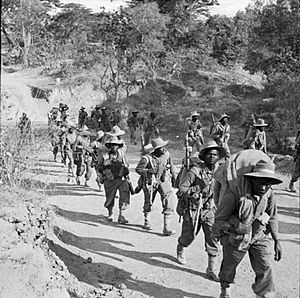
The KAR fought in several important campaigns during World War II. They fought against the Italians in Italian East Africa. They also fought against the French in Madagascar during the Battle of Madagascar. Later, they fought against the Japanese in Burma during the Burma Campaign.
In 1940, the Somaliland battalions bravely defended their colony. They fought against the Italian invasion. However, they had to retreat after losing the Battle of Tug Argan.
Later, two large African divisions were formed. These were the 11th African Division and the 12th African Division. They included soldiers from East Africa, Ghana, Nigeria, and South Africa. In 1941, Sergeant Nigel Gray Leakey of the KAR won the Victoria Cross for his bravery.
In 1943, the 11th (East Africa) Division was formed again. This division fought in Burma. Two other brigades from East Africa also went to India to fight in Burma. By the end of the war, the KAR had grown to 43 battalions. They also had other units like armoured cars and artillery.
After the Second World War
The regiment played a big part in the Mau Mau rebellion in Kenya (1952–1960). Some soldiers from the regiment were accused of serious actions during this time.
The 1st, 2nd, and 3rd battalions also served in the Malayan Emergency. They fought hard against Communist rebels there.
In 1957, the regiment changed its name to the East African Land Forces. Queen Elizabeth II was the last special leader of the KAR.
As different African countries became independent, the KAR slowly broke apart. Its battalions became the core of new national armies:
- 1st Battalion – 1st Battalion, Malawi Rifles
- 2nd Battalion – 2nd Battalion, Northern Rhodesia Regiment (later Zambia Regiment)
- 3rd Battalion – 3rd Battalion, Kenya Rifles
- 4th Battalion – 1st Battalion, Uganda Rifles (later part of the Ugandan Army)
- 5th Battalion – 5th Battalion, Kenya Rifles
- 6th Battalion – 1st Battalion, Tanganyika Rifles
- 11th Battalion – 11th Battalion, Kenya Rifles
- 26th Battalion – 2nd Battalion, Tanganyika Rifles
Today, the Kenya Rifles and the Malawi Rifles still exist. They carry on some of the KAR's traditions.
Battle Honours: KAR's Achievements
The KAR battalions did not get special flags (called colours) until 1924. These flags had many of the regiment's battle honours (awards for bravery in battle) on them. The old flags were replaced in the 1950s.
Here are some of the battles and campaigns where the KAR earned honours:
- Ashanti 1900, British Somaliland 1901–04
- The Great War: Kilimanjaro, Narungombe, Nyangao, East Africa 1914–18
- The Second World War: Afodu, Moyale, Todenyang-Namuraputh, Soroppa, Juba, Beles Gugani, Awash, Fike, Colito, Omo, Gondar, Ambazzo, Kulkaber, Abyssinia 1940–41, Tug Argan: British Somaliland 1940, Madagascar, Middle East 1942, Mawlaik, Kalewa, Seikpyu, Letse, Arakan Beaches, Taungup, Burma 1944–45
Famous People in the KAR
Many people served in the King's African Rifles. Some became very famous later on.
- Idi Amin: He served in the KAR from 1946 to 1962. He later became the President of Uganda.
- Roald Dahl: This famous British writer, known for children's books like Charlie and the Chocolate Factory, served in the KAR in 1939.
- Nigel Leakey: A British soldier who served from 1939 to 1941. He was awarded the Victoria Cross for his bravery.
- Waruhiu Itote: He served from 1942 to 1945. He later became a leading figure in the Mau Mau rebellion.
See also
- African Distinguished Conduct Medal
- Bikaner Camel Corps
- Gold Coast in World War II
- History of Anglo-Egyptian Sudan
- Kenya in World War II
- Kenya Regiment
- KiKAR
- King's African Rifles Long Service and Good Conduct Medal
- Nyasaland in World War II
- Order of Battle, East African Campaign (World War II)
- Rhodesian African Rifles
- Somaliland Camel Corps
- Southern Rhodesia in World War II
- Sudan Defence Force



